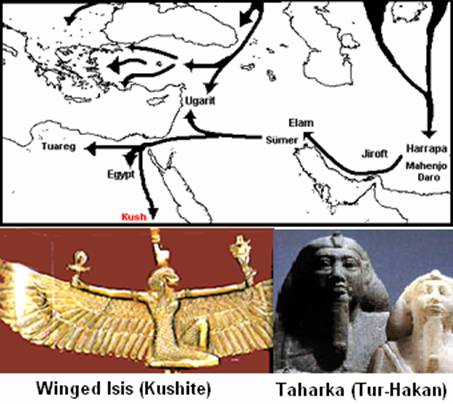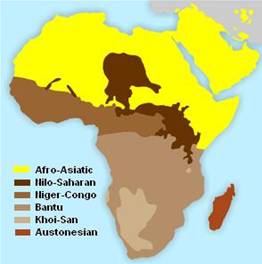|
In the
previous Chapter 25, From
Kurgans to Pyramids, I mentioned that Kush meant
“bird” in Turkish and that this ancient nation was located in
the south of Egypt (see map below). I am of the opinion that
the Kushites did not originate from Africa, but came to these
regions from the north. Here are some indications supporting
this opinion.

Birds,
as mentioned in Chapter 3, The
Hidden Meaning of Petroglyphs, were accepted to be
sacred animals due to their capacity of being able to fly in
the sky; the region where the sun resides. The Kushites also
venerated the sun and created anthropomorphic images of winged
gods and goddesses, as shown above.
One of the
most renowned king of the Kushite empire was
Taharka, but his
original name was Týr- Haka
or Tur- Hakan
meaning “the king of the Tur people” (see Chapters 8 and 24).
The word “Tur” (pronounced as “toor”) has been modified to
“Moor” by the Romans who came to North-Africa around second
century AD. Moor
became a generic name for brown people of North-Africa and
later on of Iberian Arabs as well as of the Berber and Tuareg
(Toor-Oc) people of North-West Africa.
The
countries Mauritania and Morocco both contain the root-word
“Toor / Moor”. How did the country name “Morocco” appear? It
is most probable that it suffered the following
transformations: Toor-Ok =>
Moor-Oc => Morocco,
a clear relation to the Oc people. We also have “Maurus” in
Latin, “Mavro” in Greek, “Mauve” in French, “Mohr” in German,
“Mor” in Turkish, all meaning “purple”, identifying the
North-Africans (moor) with their suntanned skin color.
Meröe,
the main city of the Kushites and the plains of
Moab,
where the Moabites once lived are also names related to Moor.
The plains of
Moab are in the low valleys of the Jordan River neighboring
Ugarit (see map above).

These
names are all connected to the Asiatic “Toor” and “Oc” people
who migrated towards the south-west. A further clue in this
direction is the similarity of the facial appearances shown
above. Olmec people lived in Central America and carved huge
stone heads of their leader. The sphinx head in front of the
Khafra pyramid in Egypt has the same features as the ones of
the Mongolian ruler Chengiz Han and the Kushite leader Taharka
(Turhakan). Adding these clues to the detailed elaborations of
the previous chapters we can conclude that ancient North
African tribes came to these regions from Central Asia.
This African
expansion happened maybe 7,000 years BP and its remaining
traces are rather fuzzy, therefore not clearly stated in any
history book. The purpose of the present investigation is, as
mentioned in the introduction, to remember the forgotten past.
The
languages spoken by North-African and Eastern-Mediterranean
people has been designated by linguists as being Afro-Asiatic;
a clear indication of their Asiatic connection. The branches
of Afro-Asiatic are Berber (Tuareg), Chadic, Kuschitic,
Egyptian, Omotic and Semitic. The map below shows the language
groups of Africa and the extent of the Afro-Asiatic languages
(1).
The Afro-Asiatic language group extends up to Sudan and
Ethiopia, supporting the view that the Kushites did not
originate from Central or Southern Africa.

Regarding the Olmec faces shown above, we know that these
people lived along the Gulf Coast in what is now southern
Mexico and Guatemala. Together with the Toltecs they were the
early settlers of the region and had a distinctive cultural
style including a special pictographic script. Their culture
flourished from 1800 BC to 400 BC and during this period they
carved many stone monuments, including colossal carved basalt
heads that have characteristic Asiatic features. Until now 16
basalt heads measuring up to three-and-a-half meters have been
found
(2).
Another clue for their Asiatic origin is the pyramid-like
mounds built by the Olmec in La Venta, an important ceremonial
center of this culture. More details will be given in the next
chapter.
|